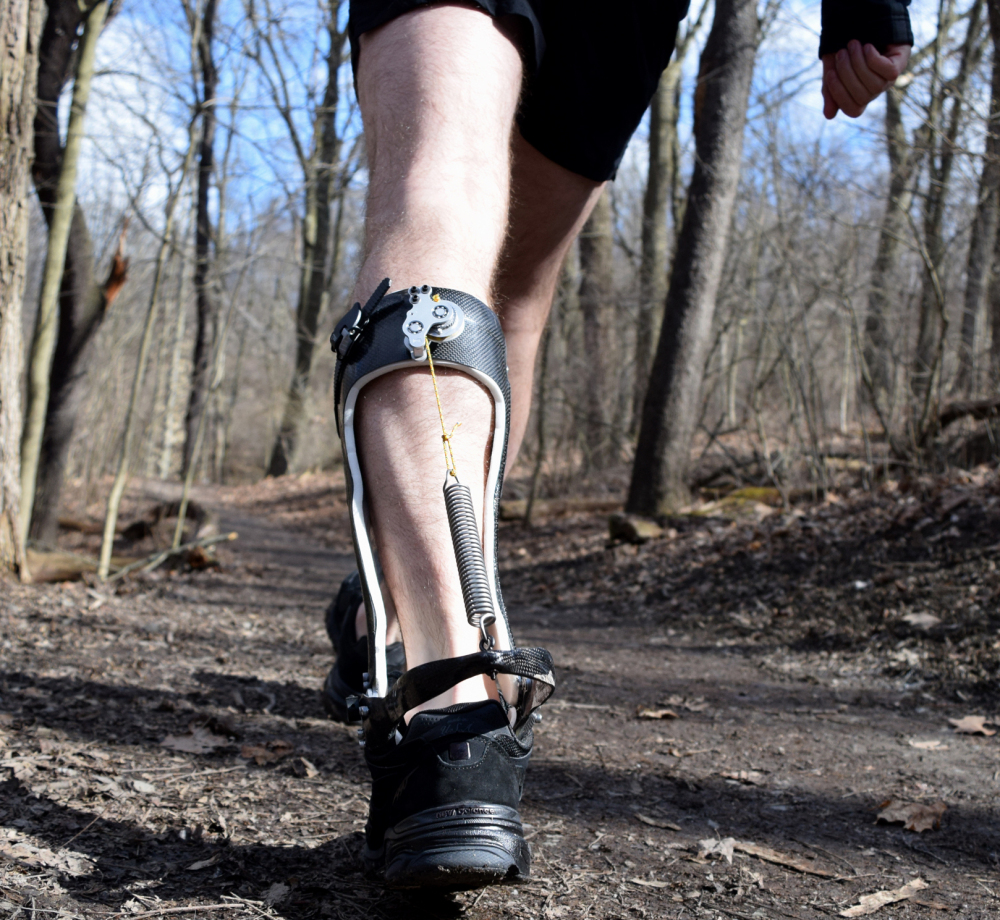The latest exoskeleton technology doesn’t need an outside power source to boost your strength. It harnesses the power of your own muscles to put a spring in your step instead. And soon baby boomers could be using it to keep hiking and jogging just a few years longer.
The new devices, described Wednesday in Nature, are still just in the prototype phase. But the researchers who created the inexpensive, easy-to-wear exoskeletons believe they could be ubiquitous in another decade. They’re quite unlike the hulking, “Iron Man”-like suits that others have created to help people walk more easily. These little braces don’t require any outside power, and they make walking 7 percent more efficient with nothing but a well-placed spring system. They can’t support someone who can’t stand on her own like a bulkier, motor-aided suit might. But for people who can walk but have difficulty doing so, the boot-like new apparatus could help create a more balanced, comfortable gait.
Just under 10 percent less energy per step doesn’t sound like much – it’s the equivalent of removing a 10-pound backpack. According to study co-author Gregory Sawicki, a biomedical engineer and locomotion physiologist in the joint NC State/University of North Carolina-Chapel Hill Department of Biomedical Engineering, people using the braces don’t really notice the difference – until it’s gone.
“I’ll tell you, it feels really cool,” Sawicki said. “There’s a comfortable sort of squishiness for the first 10 minutes. But then it becomes totally transparent. Your body just integrates it.”
And since the current iteration of the prosthetic is custom-molded, they’re also super comfortable.
“When you take it off, you’re like, ‘oh, crap,’ ” Sawicki said. “You don’t realize how much it helped until it’s gone. You feel really clunky for a few minutes.”
Sawicki and his co-author Steve Collins (an assistant professor of mechanical engineering at Carnegie Mellon) think the most immediate application for their design will be to help people with partial paralysis — stroke victims in particular — who can walk, but struggle to do so.
Collins and Sawicki first started working on the idea as graduate students at the University of Michigan about a decade ago. Sawicki had created a pneumatic prosthetic that pumped air up against the ankles of the wearer to give them an extra push. But it was clunky, and had to be plugged into a power source in the lab.
Once the men decided to create an exoskeleton that didn’t need outside power at all, Sawicki studied muscle physiology to come up with a better solution. The result is a sort of catapult built around a comfortable boot. A clutch allows the natural pull of your foot to tighten up a spring behind the calf, then releases it as your leg moves back and returns the energy to you.
“It’s harder to do it this way, of course,” Collins said. “Instead of adding an energy source to allow your muscles to expend less energy themselves, you’re just building a system that uses less energy as a whole. But the challenge is what drew us to the problem. After 7 million years of evolution as bipeds and some tens of thousands of hours of practice throughout a lifetime, is it even possible to reduce the energy of walking?”
Collins and Sawicki are quick to point out that their design is a prototype, not a fully-fledged product. They still need to figure out how to make it in boot-like sizes instead of custom molding each piece, and they’d like to tweak the materials for mass production.
As it stands, their device costs only a couple thousand dollars to make, compared with the tens of thousands a motorized suit would cost, and they both say it makes walking easier. With that in mind, they have hopes of breaking into the baby boomer market.
Send questions/comments to the editors.



Success. Please wait for the page to reload. If the page does not reload within 5 seconds, please refresh the page.
Enter your email and password to access comments.
Hi, to comment on stories you must . This profile is in addition to your subscription and website login.
Already have a commenting profile? .
Invalid username/password.
Please check your email to confirm and complete your registration.
Only subscribers are eligible to post comments. Please subscribe or login first for digital access. Here’s why.
Use the form below to reset your password. When you've submitted your account email, we will send an email with a reset code.